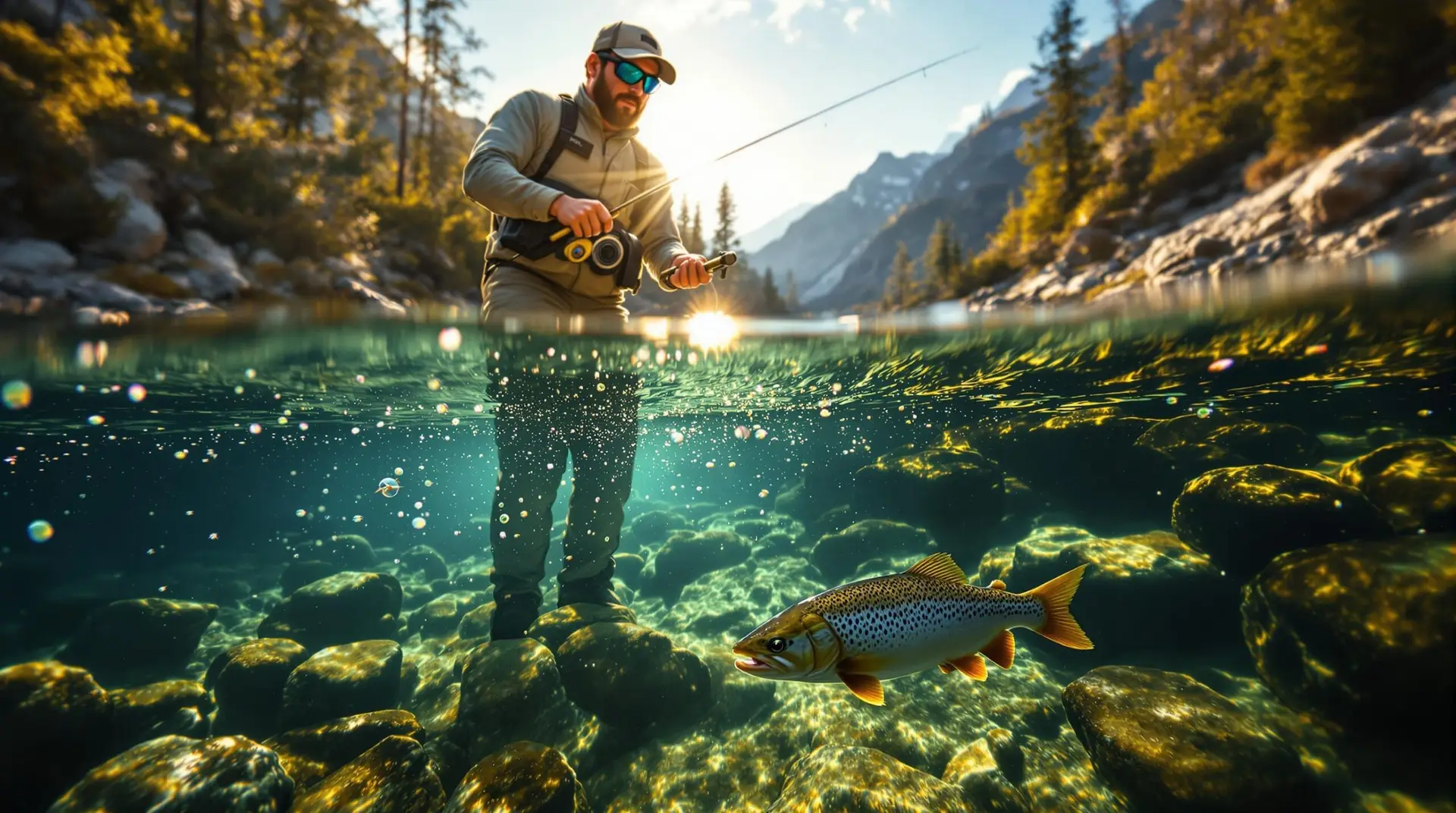Mastering Nymphing Techniques
Effective Nymphing Strategies
Getting the hang of nymphing is all about keeping your fly just right—floating smoothly in the water with the kind of buoyancy that a real nymph would have. They don’t trudge along the bottom; they kind of hover. So, you’ve got to do the same to make it look like the real deal. Anglers at the top of their game have a few tricks up their sleeves for keeping that fly gliding without hitting rock bottom too often.
Here’s a quick rundown:
- Go for super skinny and long leaders to get that drift looking natural.
- Try keeping that line tight with contact nymphing techniques, so you feel even the slightest nibble.
- Play around with where you put weights on your rig to find that sweet spot for depth and drift (nymph rig weight placement).
- Toss on some tungsten beads to help sink your nymph fast without dragging it down to the river’s floor.
Importance of Avoiding the Bottom
The name of the game with a top-down nymphing approach is to start high in the water and slowly work your way down. You want that nymph swimming naturally to catch the eye of a hungry trout, not snagging every rock and twig on the bottom. Focus your drifts at different levels before even thinking about touching the bottom, and you’ll save yourself the headache of constantly untangling and retying your flies.
| Aspect | What it does |
|---|---|
| Top-Down Approach | Gradually checks out the full range of a trout’s lunch zone without hitting the bottom too soon. |
| Avoiding Bottom Snags | Keeps you fishing more rather than playing knot surgeon. |
| Realistic Presentation | Makes it seem your nymph could be alive and kicking right there in the water with the rest of ’em. |
With these tips in your fishing arsenal—balancing how deep you go and how your fly sways in the current using advanced euro nymphing methods—you’ll find your catch rate going up in no time.
To dive deeper into making these techniques work for you, check out our detailed guides on nymph drift mechanics and multiple nymph rigs. For the full lowdown on nymphing tricks and tips, swing by our how to euro nymph page.
Refining Your Nymphing Approach
Top-Down Nymphing Method
Ever tried fishing all fancy-like from the top-down? Well, this technique is all about drifting your nymphs starting from the top of that watery hunting ground. Imagine not having to pull out another snarl of tangled lines and hooks from the river’s clutches. Using this technique helps you gracefully cover different depths, making fishing a little more like art and less like a wrestling match with underwater debris.
To kick things off, get those nymphs gliding through the upper layers of the strike zone. Start shallow, let those sweet little drifts happen, then gently nudge them deeper each go-round. It’s like sending out an invite to those sneaky fish, one drift at a time. No more repetitive snagging and cursing your luck – just smooth layers of depth exploration.
Why bother with this top-down shindig? Here’s why:
- Less time fighting with tangled gear means more time fishing.
- You can get all artsy with how you present your bait.
- The rhythmic nature of the process ups your odds for a whopper catch.
And let’s face it, being able to feel the difference between a feisty fish and yet another stubborn rock makes you a better angler because now you’re dodging those wannabe strikes (“hey, I’m not food, I’m just a rock!”). Need more fine-tuning on that nymphing game? Check out our meaty guide on advanced euro nymphing.
Elements of Effective Nymphing Rigs
Want to make sure your fishing tackle is up to scratch? A killer nymphing rig might just be what the fish ordered. Here’s the lowdown on what you should tweak for those deep dives: weight placement, leader setup, and nymph patterns that get the fish talking.
Weight Placement
If you’re sinking like a lead balloon, you’re doing it right. But seriously, scatter that weight so your nymphs hit the strike zone like a pro and don’t end up doing a tango with underwater weeds. Curious? There’s a whole guide on getting that nymph rig weight placement just right.
Leader Setup
Got a great cast but can’t feel the pull? Maybe tweak that leader setup. A long, tapering leader might just gift you that Sixth Sense…for fish. Don’t believe me? Peep our guide for a stellar nymphing leader setup.
Nymph Patterns
Thinking heavy metal in water? Tungsten bead nymphs are the way to go if you’re fishing deep. They dive fast and keep the game lively. Dive into our list of the best tungsten beads nymphing.
| Element | Key Tips |
|---|---|
| Weight Placement | Control depth and avoid pesky tangles |
| Leader Setup | Boosts your sense of touch and keeps things natural |
| Nymph Patterns | Go with the weight – try tungsten beads |
When you’re poised like a fish-seducing maestro, blending all these tactics seamlessly, your paws are sure to get more tugs. And hey, if you wanna nerd out with rig setups, check the full spread on multiple nymph rigs.
Fishing isn’t just about luck; it’s a wild mix of intuition, skill, and some cunning tactics. So, for those extra edge tricks and a deep dive into fishing nirvana, don’t skip our tried-and-true tips on competition nymphing and technical nymph fishing.
Deep Water Nymphing Tactics
Fishing deep waters ain’t your regular day at the pond. People need some top-notch tricks to get their flies right where the fish hang. Let’s jump into some clever ways to add weight and a few fresh setup ideas that’ll have you reeling them in before you can say “catch of the day.”
Weighting and Sinking Techniques
Getting the weight right makes all the difference. It’s like putting on the right shoes for a night on the town—without it, you’re nowhere. Let’s break it down.
-
Split Shot Method: These little weights can make or break your fishing gig. Toss one above your flies, and watch them sink with style. Go ahead and add more during stormy sessions to up your game.
Weight Placement Effectiveness Near Flies Drops like a rock Along the Line Easy does it -
Weighted Flies: Think of using flies with some bling, like beadheads, to help them dive. Tungsten ones are like rocket boosters—fast descent, no compromise on the action.
-
String of Pearls Rigging: This uses shots placed like decorations along your line, helping the thicker parts sink fast. It’s like pulling up a sunken treasure from the depths (Gink and Gasoline).
-
Interactive Experimentation: Think of it as a fishing science fair. Play around with depths, angles, and drop rates. Learn what gets those fish dancing (Troutbitten).
Innovative Nymphing Setups
New fishing plans can give the maestro another instrumental piece in their toolbox for deep water nymphing.
-
Toilet Bowl Drop Shot: Stick three flies on tags, weight them down, and let ’em sink to the bottom like they’re in a free fall. When your line starts doing the salsa, get ready for a catch.
-
Multi-Fly Rigs: Using a team of different flies can hit various spots in the water. Use a mix to cover your bases and see what the fish like today (multiple nymph rigs).
Rig Setup Benefit Group of Nymphs Hits all zones Tagging with Weight Perfect vertical drop -
Euro Nymphing Techniques: These fancy methods like contact nymphing technique keep you in control so you can feel those weak tugs and react quickly.
Mastering these tips and setups means more fish and fewer missed chances. Blend ’em with a touch of advanced euro nymphing know-how, and you’ll soon be the talk of the waterway. Dive deeper with our full guide on nymph drift mechanics for more juicy tips and tricks!
Get Set for Nymph Fishing
Must-Have Gear for Nymphing
Getting ready for some nymph fishing fun? You’re gonna need the right tools to really make your time in the water count. Here’s the lowdown on what you should pack:
-
Rod: The 9-foot rod is like your trusty sidekick for nymphing. It’s all about getting that line out smoothly and keeping control over it. If you’re aiming to up your nymph game, check out options for Euro nymphing rods that could step up your fishing (dedicated Euro nymphing rod).
-
Line: Go with floating line—it’ll help you nail that drift control, making life easier as you fish.
-
Leader: A leader that’s 7 1/2 feet and tapered to 4X or 5X is pretty sweet. You might have to fiddle with the length depending on how deep or fast the water is going.
-
Tippet Spools: Keep some 4X, 5X, and 6X tippet spools handy. These let you adapt to whatever Mother Nature throws your way. Tough enough yet fine for that natural presentation.
-
Weights: Little split-shot weights are your ticket to making sure your nymph sinks just right.
-
Strike Indicators: These nifty gadgets, sometimes called bobbers, alert you to what’s happening underwater (Missoulian Angler). Top nymph indicators can really streamline your fishing process.
-
Polarized Glasses: Polarized lenses knock out the sun’s glare so you can peep below the surface and spot those fishy hiding spots.
| Gear | What’s It Do? |
|---|---|
| Rod | 9 feet of magic for top casting |
| Line | Floats and keeps control in check |
| Leader | 7 1/2-foot taper for flexibility |
| Tippet Spools | Switch it up with 4X, 5X, and 6X |
| Weights | Split-shot to get that sinking feeling |
| Strike Indicators | Shows you the depth game |
| Polarized Glasses | Goodbye glare, hello fish |
Tricks for Different Waters
Euro nymphing isn’t a one-size-fits-all deal. Depending on where you’re fishing, you gotta mix up those techniques to match the environment:
-
Shallow Streams: Go light with your nymphs here and don’t overdo it with weights. A short line nymphing strategy can score you more fish (short line nymphing). Keep those strike indicators close so they don’t drag.
-
Deep Rivers: Time for the heavy-duty setup: weightier nymphs and a handful of split-shots. Try high-stick nymphing for more control (high stick nymphing) to keep your bait in the bite zone.
-
Fast Currents: Working in rapid waters? Depth control’s king. Mix weights and indicators to lock the nymph in place (nymph indicator techniques). Adjust your indicator position to be about 1.5 times the water’s depth.
-
Stagnant Waters: In the slower waters, lighten up your line setup and get the drift just right. Use quieter approaches and fine tippets to not scare away the fish before you get your shot.
By switching up your tactics to match the water type, you can really crank up your Euro nymphing game (advanced Euro nymphing).

